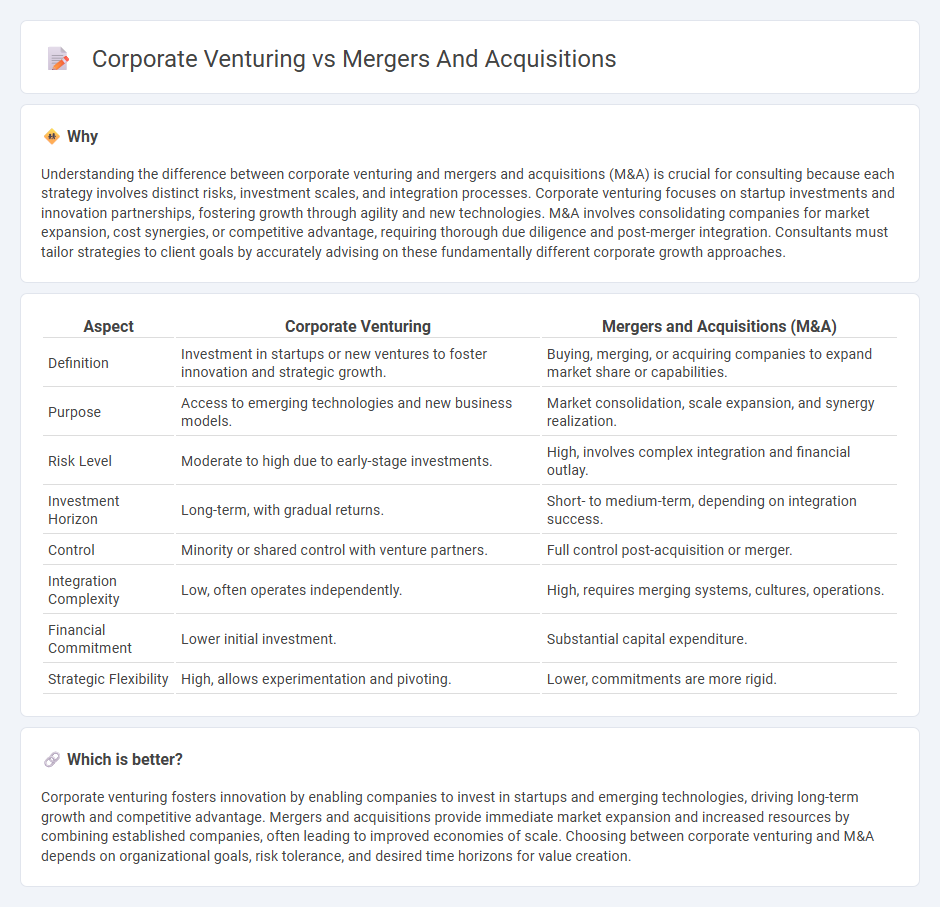
Corporate venturing fosters innovation by investing in or partnering with startups to accelerate growth and access new technologies, offering flexibility and long-term strategic benefits. Mergers and acquisitions involve the direct purchase or consolidation of companies to achieve immediate scale, market share, and operational synergies, often requiring higher capital investment and integration efforts. Explore the strengths and strategic implications of each approach to determine the best fit for your organizational goals.
Why it is important
Understanding the difference between corporate venturing and mergers and acquisitions (M&A) is crucial for consulting because each strategy involves distinct risks, investment scales, and integration processes. Corporate venturing focuses on startup investments and innovation partnerships, fostering growth through agility and new technologies. M&A involves consolidating companies for market expansion, cost synergies, or competitive advantage, requiring thorough due diligence and post-merger integration. Consultants must tailor strategies to client goals by accurately advising on these fundamentally different corporate growth approaches.
Comparison Table
| Aspect | Corporate Venturing | Mergers and Acquisitions (M&A) |
|---|---|---|
| Definition | Investment in startups or new ventures to foster innovation and strategic growth. | Buying, merging, or acquiring companies to expand market share or capabilities. |
| Purpose | Access to emerging technologies and new business models. | Market consolidation, scale expansion, and synergy realization. |
| Risk Level | Moderate to high due to early-stage investments. | High, involves complex integration and financial outlay. |
| Investment Horizon | Long-term, with gradual returns. | Short- to medium-term, depending on integration success. |
| Control | Minority or shared control with venture partners. | Full control post-acquisition or merger. |
| Integration Complexity | Low, often operates independently. | High, requires merging systems, cultures, operations. |
| Financial Commitment | Lower initial investment. | Substantial capital expenditure. |
| Strategic Flexibility | High, allows experimentation and pivoting. | Lower, commitments are more rigid. |
Which is better?
Corporate venturing fosters innovation by enabling companies to invest in startups and emerging technologies, driving long-term growth and competitive advantage. Mergers and acquisitions provide immediate market expansion and increased resources by combining established companies, often leading to improved economies of scale. Choosing between corporate venturing and M&A depends on organizational goals, risk tolerance, and desired time horizons for value creation.
Connection
Corporate venturing and Mergers and Acquisitions (M&A) are interconnected strategies that companies use to drive innovation and growth by acquiring or investing in startups and emerging businesses. Corporate venturing allows companies to explore new technologies and markets through equity investments or partnerships, while M&A involves full-scale integration or acquisition of companies to expand capabilities and market share. Both approaches enable organizations to accelerate their innovation pipeline, diversify portfolios, and enhance competitive advantage in rapidly evolving industries.
Key Terms
Due Diligence
Mergers and acquisitions (M&A) due diligence involves a comprehensive evaluation of financials, legal risks, and operational synergies to ensure value creation and risk mitigation. Corporate venturing due diligence prioritizes the assessment of innovation potential, market fit, and strategic alignment with startup culture. Explore how tailored due diligence approaches maximize success in both M&A and corporate venturing contexts.
Strategic Fit
Mergers and acquisitions prioritize strategic fit by integrating complementary assets and capabilities to enhance market position and operational efficiency. Corporate venturing focuses on strategic fit by fostering innovation and accessing emerging technologies through partnerships or investments in startups. Explore how aligning strategic fit in both approaches drives sustainable growth and competitive advantage.
Innovation Pipeline
Mergers and Acquisitions (M&A) offer rapid access to new technologies and market segments by integrating established companies, while corporate venturing fosters innovation through strategic investments in startups and emerging ventures, maintaining agility and external creativity. The innovation pipeline benefits from M&A's scale and resource consolidation, contrasted with corporate venturing's experimental approach that nurtures groundbreaking ideas within a dynamic, risk-tolerant environment. Explore how balancing M&A and corporate venturing can optimize your innovation pipeline and drive sustainable growth.
Source and External Links
Mergers and acquisitions - Wikipedia - Mergers and acquisitions (M&A) are transactions where ownership of companies or units is transferred or consolidated, allowing businesses to grow, downsize, or change competitive positions, with mergers being a legal consolidation into one entity and acquisitions involving one entity taking ownership of another, often regulated under antitrust laws.
Mergers & Acquisitions (M&A) - Corporate Finance Institute - M&A transactions combine two companies by merger (forming a new entity) or acquisition (where one absorbs the other), and include types like horizontal, vertical, statutory, and subsidiary mergers, serving strategic goals such as consolidation and diversification.
Merge and acquire businesses | U.S. Small Business Administration - Mergers combine two firms into a new legal entity, while acquisitions absorb one company into another without forming a new company, requiring business valuation, negotiation of sales agreements, and thorough documentation to address assets, liabilities, and operational arrangements.
 dowidth.com
dowidth.com